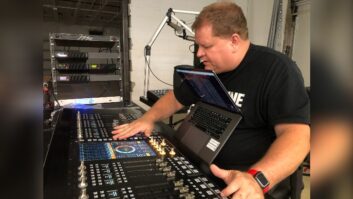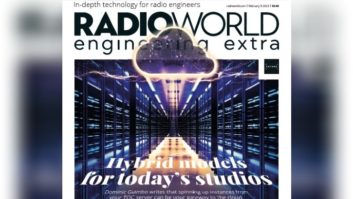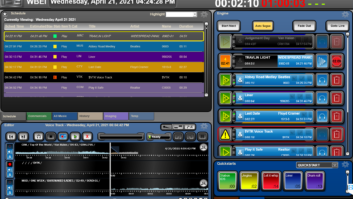The author is a broadcast automation specialist at ENCO Systems.
In recent years, virtualization has gained in popularity among a multitude of industries because of its versatility and lower cost of ownership. Such a trend has also caught on in the broadcast industry where broadcasters constantly look for ways to do more with less.

Fig.1: An example of a virtual automation environment. The single hardware core runs an instance of the operating system and automation software for each of the workstations. To the user, it appears the automation is running on a single computer.WHAT’S A VIRTUAL ENVIRONMENT?
If you’re unfamiliar with the concept of virtualization, imagine an extensive network of keyboard, video and mouse (KVM) extenders to connect workstations to the monitor, mouse and keyboard in the studio, except imagine replacing the individual workstations with one single hardware unit that hosts all of the individual operating systems.
The result is a virtual environment. Fig. 1 shows an example. To a user, it appears that the software is running on a conventional, physical computer.
The current model of using standalone workstations requires each computer to have its own drive for storage, processor and RAM. With the virtual computing model, however, hardware resources are shared among the different virtual workstations. This is made possible because a number of virtual workstations can run on a single hardware unit. The many advantages provided by a virtual environment have made this technology popular in the broadcast industry.
REDUCE THE TOTAL COST OF OWNERSHIP
One of the principle advantages of virtualization is the reduction in Total Cost of Ownership. While the initial capital outlay may be higher than traditional automation workstations, the cost savings are realized in lower maintenance costs and hardware upgrades. This is due, in large part, to the fact that the centralized hardware is a shared resource utilized by every virtual workstation and file server on the network. Additionally, the cost of powering and cooling the system is drastically lower than powering and cooling the multiple computers of a traditional system, especially considering the power drawn when systems are in standby.
The initial deployment of a virtual system is easier than deployment of traditional workstations because everything is in one box and all control points are connected by simple network cabling. An existing audio over IP (AoIP) network provides further ease when deploying a virtual automation system. These attributes also make relocating a virtualized system very simple.
Furthermore, when station personnel decide it is time to upgrade the hardware, the upgrades can be done quickly and with less downtime.
With a virtual system, any studio can access any workstation session using the thin clients. This enables operators to use studios as a multipurpose space. Operators can go live to air from any studio or can use any of the available studios for production work.
Finally, a virtual system protects your facility against data loss because of its ability to keep redundant copies of audio assets and databases. This redundant environment allows for easy virus removal and cloning of virtual workstations to scale upward as your facility’s needs change.
REDUCED MAINTENANCE COSTS
When all virtual workstations share a common set of hardware components, maintenance of the system is far less expensive than replacing or upgrading the same components on each hardware workstation. Along with being cost-effective to replace or upgrade hardware components, a virtual system also makes it easy, as there is only one centralized hardware unit on which to perform maintenance. Many of today’s hardware units allow components and drives to be hot swapped so the virtual machines do not need to be shut down to render maintenance. This provides better uptime over traditional hardware units and allows the on-air program to continue running uninterrupted.
CENTRALIZED STORAGE AND SAFEGUARDING DATA
With a virtual system, all files are stored on the single hardware unit and can be retrieved from any client with little effort. To accomplish this, all data are stored on one hardware unit in most cases with redundant drives. Centralizing data is crucial to keeping a system clean and organized, but could be vulnerable if not highly redundant. It is also important that hardware issues do not interrupt system operations. Some hardware units allow for a seamless recovery in the event of a hardware failure in the unit.
STUDIO SPACE IS NOT FIXED IN ITS FUNCTIONALITY
Traditionally, studios have been functionally fixed; that is, an air studio was an air studio, and a production studio was used for production. To create multipurpose studios was certainly possible but not always practical. Within a virtual environment, workstations are not assigned to any particular control point, thus any client can control any workstation. With this level of versatility, and the flexibility of an AoIP routing system, any studio can be used for any purpose regardless of its original intended use.
Being able to create these multipurpose studios is tremendously efficient, especially during busy times such as pledge drives or during a heavy news cycle when talent might be waiting on a production studio.
On the automation side, the appropriate session can be called up at the thin client located in the studio. Within the AoIP environment, the operator would select the profile on the console that matches their production needs.
One potential limitation with a virtual system housed in a single hardware unit is a lack of physical inputs and outputs. Fortunately, much of today’s broadcast equipment communicates both media assets and system control over IP-based networking and thus can easily be connected into a virtual environment. Furthermore, software licenses can be used in place of USB security keys to circumvent issues related to a limited number of USB ports.
A virtual automation environment has some clear advantages over the traditional workstation model, and stations are beginning to take advantage of the ease and versatility. It is important to evaluate the needs of a station and determine how a virtual environment can improve the workflow, data security and maintenance requirements. The next time you are evaluating the automation system hardware at your facility, it may be worth your time to take a serious look at what a virtual system can do for you.
Paul Stewart is a member of the Society of Broadcast Engineers; he is actively involved with the Michigan Association of Broadcasters and began contributing to the MAB Engineering Committee in May 2015.












